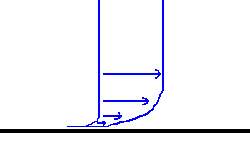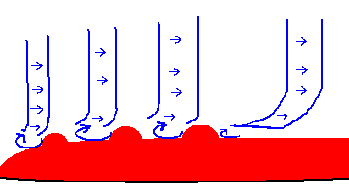| As a fluid travels over a surface, it follows boundary layers, much like the example on the right. A flow can be thought of as many of these type of structures as they move along a surface. The size of the arrows indicate the velocity inside the flow. |
|
| Lets say you go to the store
and purchase a Frisbee of the shelf. If you look at the surface on
the top of the disc you will probably see raised rings running around
the circumference of the disc. THESE ARE NOT DECORATION.
The purpose of the rings is very interesting. As the air flow
separates and travels over these rings, turbulent flow occurs. (Please again, bear with my drawing..) |
|
| This turbulence is actually beneficial to the disc. The longer the air flow is in contact with the disc, the longer the flight time. This also limits the drag experienced when the air flows, which are now separated, reattach to one another. |
| As strange as this sounds, its actually practiced quite religiously by disc golfers. After purchasing a new disc, golfers will purposely try to "mar" the surface of the disc. This is the same concept at the pre-molded rings. |
| Turbulence also takes place
inside the cavity of the Frisbee. As the air flow begins traveling
to the underside of the disc, the boundary layer actually looses contact
with the disc for a short period of time. It this reattaches to
the surface in time to hit the trailing underside edge of the disk.
This not only causes a turbulent flow, but a small flow in the opposite
direction of the airflow.
|
|
|
It is possible to see this in the right picture. Picture (b) shows the underside of a disc with a paint mixture tracer to show the air flow. At the (F) region the boundary layer comes back into contact with the disc and begins flowing, against the overall flow, back towards the leading edge (top portion of Frisbee). (3) |


